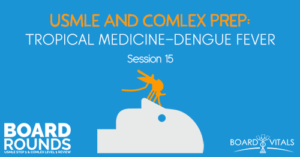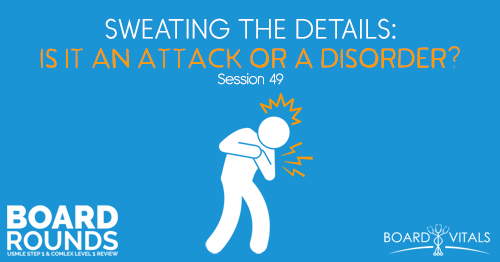Apple Podcasts | Google Podcasts

Session 15
This week, we’re joined by Dr. Karen Shackelford from BoardVitals.
If you’re looking for more prep with your USMLE Step 1 or COMLEX Level 1 training, visit BoardVitals and check out their QBanks for Step 1 and Level 1.
Sign up for either 3 months, 6 months, or even 1 month. Your signup will have a vaccine donated through the #GiveVax program. If you sign up for the 3 months and 6 months, you’ll get access to Ask a Clinician, where you can connect with the BoardVitals medical experts to answer your content questions.
Use the promo code BOARDROUNDS to save 15% off of your purchase.
[02:17] About Dr. Karen Shackelford
Karen is a former ER clinician. She did her residency in medical school at the University of Mississippi. She eventually moved to Pennsylvania and began working remotely with BoardVitals as a contributor and editor.
[03:20] Question of the Week
A 35-year-old female patient returned 10 days ago from a mission trip to Nigeria. He was evaluated in the clinic a week ago, complaining of a high fever. She had a rash on the axilla, face, and extremities.
The symptoms she had experienced were similar to some she had two years earlier after returning from the same mission trip. Those symptoms resolved with only symptomatic treatment.
Today, her husband took her to the emergency department reporting that her fever had resolved two days ago. But she began to complain about abdominal pain and then she appeared very lethargic.
On exam, her skin is cool and blocky. She had circumoral sinuses. Her pulse is weak and rapid. And her blood pressure is 80/60 mm Hg. She has a diffused confluent rash and her liver 2 cm below the costal margin.
Laboratory studies are significant for a platelet count of 70,000 cells/mL. White blood cell count is 2,000 cells/mL with predominant lymphocytosis. Her serum aminotransferase is elevated.
Which of the following is most likely caused by these severe symptoms?
(A) Has bacterial super infection
(B) Inoculation with a larger viral load
(C) Antigenic drift
(D) Different viral serotype change
[05:08] Thought Process Behind the Answer
Antigenic drift is characterized by small changes in the viral structure. It denotes spontaneous changes in the viral type. This is how viruses avoid getting destroyed by vaccines.
Serotype is defined as a serologically different strain of microorganism with slight structural differences. They’re classified together and have the same type of immune response. But just with a slight variation in their effect on the immune system.
The correct answer here is D.
The patient, in this case, is her second infection with Dengue Virus but with a different serotype. There are four serotypes of that virus. It’s not atypical for somebody to have a mild case that resolves or even asymptomatic initial infection.
At that time, the virus presents to a naive immune system. The second time around, it triggers a more significant immune response instead of immunity because of the antigenic differences that the virus responds to.
A lot of these viruses are becoming more common in areas that people routinely travel to. A severe viral infection can resolve in hemorrhagic fever and epistaxis, hepatomegaly, circulatory shock.
And it resolves through increased capillary permeability because the immune system is having a fluoric response to this second exposure to a slightly different serotype.
[10:05] Third Infection
If she had a third infection with Dengue Virus, it could be another viral serotype which can be potentially harmful. Although you might have some measure of immunity against the same one.
When somebody comes into the office in the Emergency Department with a history of travel to the tropics and they have fibromyalgia, lethargy, and a rash, there are several things that could be wrong with them.
Check on Chikungunya fever or dengue fever. They should be considered. But the one that is potentially fatal is dengue. The person could seem to recover. The fever could resolve. They could also become progressively ill and have circulatory collapse several days later. Hence, they should be monitored closely after an episode.
The tests for these two are not readily available in those hospitals. So close monitoring should be done if they’re coming with acute high fibromyalgia, lethargy, and rash after a trip to the tropics.
[11:50] Potential Questions
Both fevers are viral and both transmitted by the Aedes mosquito. There’s not a vaccine and not a specific treatment. It’s just supported. In most cases, the initial infection is asymptomatic or mild asymptomatic.
Increased formation in immune complex so she has a pretty flourid response to dengue fever would be the primary mechanism behind it. Again, no specific treatment.
Links:
BoardVitals (promo code BOARDROUNDS to save 15% off)
SEARCH SITE
LISTEN FOR FREE











